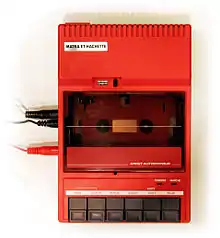Matra Alice
The Matra & Hachette Ordinateur Alice is a home computer sold in France beginning in 1983. It was a clone of the TRS-80 MC-10, produced through a collaboration between Matra and Hachette in France and Tandy Corporation in the United States.

 The Matra Alice | |
| Manufacturer | Matra and Hachette |
|---|---|
| Type | Home computer |
| Release date | 1983 |
| Discontinued | 1983 |
| Operating system | Microsoft BASIC |
| CPU | Motorola 6803 |
| Memory | 4 KiB on-board |
| Display | Motorola 6847 |
| Input | Cassette interface |
| Connectivity | RS-232C serial interface |
| Backward compatibility | TRS-80 MC-10 |

The Alice is distinguished by its bright red casing. Functionally, it is equivalent to the MC-10, with a Péritel (SCART) connector replacing the RF modulator for video output.
The Alice never became a popular computer in its home country. It tried to invade schools by being part of the country's Informatique pour tous ("Information technology for everyone") programme, but Thomson won the whole deal.
The original model had 4 kB of RAM and used a Motorola 6847 video display generator chip, as used in the Dragon 32 and Acorn Atom among others.
Specifications
- CPU: Motorola 6803
- RAM: 4 KiB on-board
- ROM: 8 KiB (Microsoft BASIC)
- I/O Ports:
- AZERTY keyboard layout
All other specifications should be comparable to those of the TRS-80 MC-10, but have not been confirmed.
Successor Models

Matra later released two successor models:
- The Matra Alice 32 released in 1984 shared the case style of the original, but was a different computer inside, due to using the EF9345 video chip. The Alice 32 had 8 kilobytes of main RAM, 8 kilobytes of dedicated video RAM, and 16 kilobytes ROM (the ROM incorporated an assembler).
- The Matra Alice 90 released in 1985 was an upgrade to the Alice 32, which featured 32 kilobytes of RAM and a full-size case and keyboard. Its video cable included video-in, so EF9345 graphics could be overlaid onto the input video.
The EF9345 video chip in the Matra Alice 32/90 was capable of displaying 8 colors, 128 alphanumeric characters, and 128 semi-graphic characters with a semigraphic mode and 40- and 80-column text modes. It could address up to 16 KiB of dedicated VRAM although the Alice 32 and 90 only included 8 KiB.[1] The 32x16 semigraphic mode of the original Alice was simulated in software by the Alice 32/90 system ROM.[2]
References
External links
| Wikimedia Commons has media related to Alice computer. |
- Le wiki d'Alice - Everything about Alice (in French)
- Matra Alice — information from The Machine Room
- Matra Alice32 — Alice 32 information complete (in French)
- DCAlice — Alice 32 emulator and information site
- My First Alice32 — Alice 32 emulator
- FAQ on Alice32 — comprehensive FAQ regarding Alice